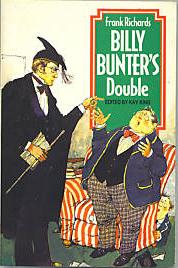Billy Bunter's Double by Frank Richards.
Published 1955 by Cassell & Co (Reprinted 1955, 1956 and 1962)
Illustrated by R.J.MacDonald.
This is the sixteenth book in the famous Cassell series. As was customary, Hamilton rehashed an old idea, here re-introducing the Fat Owl’s cousin, Walter Gilbert Bunter.
Wally, Billy’s poor relation, who worked in an office, was a familiar figure in the old Magnet.
Identical in appearance to his relation Billy, Wally could not be more different in every way. His eyesight was keen and he did not need spectacles. He was a Latin scholar capable of engaging Quelch in academic debate; he was a first-rate boxer, cricketer and athlete. Whereas Billy was untruthful, greedy, and snobbish, Wally had a sunny temperament comparable to Bob Cherry’s.
Wally had made many appearances in the old Magnet. Particularly in 1919 when he had taken his cousin’s place at Greyfriars, whilst Billy went off to St. Jim’s for a brief spell.
![]() Wally
Bunter was one of Frank Richard’s stock comic plot stand-byes. Just as any story
involving Wibley involved impersonation, and Oliver Kipps a conjuring trick, so
Wally was used to baffle the Greyfriars community with his un-Bunterish manners
and customs.
Wally
Bunter was one of Frank Richard’s stock comic plot stand-byes. Just as any story
involving Wibley involved impersonation, and Oliver Kipps a conjuring trick, so
Wally was used to baffle the Greyfriars community with his un-Bunterish manners
and customs.
In this story we find him knocking out Smithy in a fight behind the gym, discussing Virgil with Quelch, and knocking up a hatful of sixes and single runs in a cricket match where he is the star of the Remove team.
To
lovers of the pre-war story papers, this book is very tame stuff. Predictable
and formulaic.
But actually it does work well. The plot does bound along, and there are some comic scenes. Coker encounters Wally on the front at Pegg, and is upended by him. Smithy is baffled when he hears a Bunter in study number 7, only to see him mysteriously appear on the landing behind him.
Frank Richards updated many of his locations in the post-war books. Here Pegg is a thriving seaside resort, with a new cinema, boarding houses, band-stands and a crowded beach. A far cry from the sleepy fishing village of Magnet fame.
As usual the MacDonald illustrations are bland, and with the obvious exceptions – Bunter, Quelch, etc. –could have appeared in any school storybook of that era.
Smithy shows up well here, someone needs to tumble to the real truth, here it is the Bounder. It does not occur to him that the Fat Owl he has known for terms could not possibly have knocked him out in a fight. He only discovers the truth when he overhears Wally using Quelch’s phone to call Billy at the boarding house in Pegg. Otherwise, the other Removites, along with the beaks, all accept this new Bunter, who washes and is a credit to the school in every way, as the genuine article.
One mustn’t be too harsh. Many of us read these books when they were contemporaneous, and had never heard of the Magnet. I enjoyed it back in the early sixties. It is not classic FR, and cannot be compared to Beanfeast or Does His Best. That said, it is a better than average post-war Bunter story.
This book cost 7/6d in 1955; it wasn’t cheap. At the time Cassells were not numbering the spines, but it is number 16 in the series.
Sadly R J Macdonald died after illustrating this story, Mr. Chapman was to take over for the remainder of the series. In my view, a change for the better. I do not understand why Skilton did not ask him at the start.